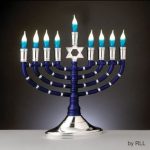It’s one of the most frequently asked questions about the observance of Hanukkah: can one fulfill the mitzvah to kindle the Hanukkah lights by means of an electric menorah? It’s frequently answered, too: most Orthodox poskim say “no.” To support this prohibition, the authorities cite a number of separate reasons: 1) the mitzvah calls for an act of “kindling” (hadlakah), and switching on an electric bulb does not meet that definition; 2) the electric bulb resembles a multi-wicked “torch” rather than a single light/lamp (ner); 3) the Hanukkah lamp must resemble the menorah in the Temple, the lights of which consisted of a wick and an exhaustible supply of fuel (oil or wax), whereas an electric light runs off the communal power grid; 4) electric lights fail to meet the requirement of pirsumei nisa, “to publicize the miracle,” because since people use them throughout the year they aren’t recognizable as Hanukkah lights; and on and on.
But what’s funny (and obviously we at this blog have a rather specialized sense of humor) is that these authorities all seem to disagree as to which reason prevails, and they tend to reject the arguments cited by others.[1] Which, of course, makes one wonder just how powerful and persuasive those arguments really are.[2] Could they be the real reason behind the opposition to the electric menorah? Besides, the poskim tend to accept the use of electric lights for the purpose of kindling the lights of Shabbat.[3] So what then makes the ner shel Hanukkah so different?
Rabbi Isaac Klein, the author of the preeminent halakhic guidebook for the American Conservative movement, suggests an answer. In his treatment of Hanukkah, where he tells us that “The weight of rabbinic opinion opposes the use of an electric Menorah,” he concludes: “In addition to the reasons cited in these sources, it should be noted that the use of candles or oil has great esthetic appeal and more sentimental meaning.”[4] We would follow up his suggestion with one of our own: perhaps, at the end of the day, it is this so-called “sentimental meaning” that drives the formal halakhic reasoning on the ner shel Hanukkah. After all, the old fashioned wicks-and-oil (or wax) menorah just feels right because, as the song has it, “it reminds us of days long ago.” It evokes the Temple, recaptured and purified by the Maccabees (even though the poskim do not all agree that the Hanukkah lights must physically resemble the menorah of the Temple). And it conveys a feeling of connection to tradition, to the way that the mitzvah of Hanukkah has been observed through the generations, a feeling to which the poskim attempt – each in his own way – to provide halakhic expression. If the technical halakhic arguments are controversial, that’s because ultimately, as Klein would have it, the issue is not truly one of technical halakhah at all. Rather, it comes down to the esthetics and the feeling.
And as long as we’re on that subject…
It has been one hundred years since Chaim Nachman Bialik wrote his seminal essay entitled “Halakhah v’agadah,” which argued that these two ostensibly dissimilar modes of Rabbinic expression are in fact intertwined in a symbiotic relationship. Halakhah and agadah, Bialik taught, speak in different voices but are opposite sides of the same coin. What this means, for our purposes, is that there is no halakhah without an agadah that guides it and that provides it with rationale and with purpose. If Bialik is right, and we’re willing to wager that he is, then it isn’t difficult to imagine that halakhic decisions, including those that prohibit[5] the electric menorah, are motivated in large part by the agadic (i.e., the ideological, political, cultural, esthetic, and emotional) commitments of the poskim who render them. To apply this to our case: the authorities who say “no” to the electric menorah are persuaded by this or that technical halakhic argument precisely because they view the mitzvah through the lens of a particular understanding of what the menorah means, of what it is supposed to represent on the level of symbol, of “esthetics,” of “feeling.” In turn, that particular understanding, which falls under the heading of “agadah,” shapes the halakhah that defines the holiday’s primary observance.
Turns out that Bialik was not only a great poet but a pretty good Jewish legal thinker. And we’re reminded of his insights into halakhic decision at this season, as we gaze into the lights – okay, the non-electric lights! – of the Hanukkah menorah.
Ḥag ha’urim sameaḥ .
_____________________________________________________________________
[1] For example, R. Eliezer Yehudah Waldenberg (Resp. Tzitz Eliezer, vol. 1:20, ch. 12) rejects reason #1 – he doesn’t think that the mitzvah requires an act of “kindling.” And he holds that the wick-and-fuel (preferably olive oil) rule is an expression of an ideal standard (mitzvah min hamuvḥar) and not an absolute requirement. And Rabbi Ovadyah Yosef (Resp. Y’ḥaveh Da`at 4:38) notes that a special ḥanukkiah – i.e., a menorah that’s obviously used for Hanukkah – answers reason #4.
[2] Rabbi Ovadyah Yosef (Resp. Yabi`a Omer 3:35) concludes his analysis of the question by stating that the matter is uncertain (safek), and that, for him, is the ultimate justification for not using an electric menorah: one should not recite a b’rakhah in a case of safek, where one is not certain that the benediction is required.
[3] Note that the blessings for the two mitzvot are virtually identical: “asher kid’shanu b’mitzvotav v’tzivanu l’hadlik ner shel Shabbat/Hanukkah.”
[4] Isaac Klein, A Guide to Jewish Religious Observance (New York: JTSA, 1979), p. 229.
[5] Again, let’s be clear: the “prohibition” is simply that one cannot fulfill the mitzvah of kindling the lights by way of electricity. The authorities don’t have a problem with the display of an electric menorah as a symbol of the holiday, so long as one does not recite a b’rakhah when lighting it.
